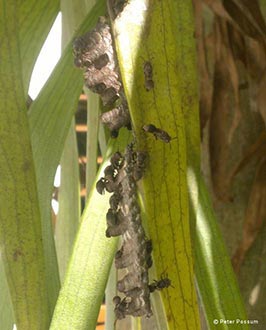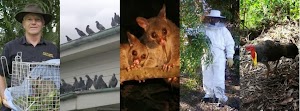1. ANIMAL DESCRIPTION
Common name: Paper Wasp
Scientific name: Australia has 2 genera, Polistes and Ropalidia
In Australia there are approximately 35 species referred to as paper wasps. They all build paper nests but the size and shape varies considerably. The ones typically found in the Brisbane area include;
The massive paper nests we get are Ropalidia romandi (Yellow paper wasp)
Lots of small hanging down vertical nests are Ropalidia revolutionalis (brown paper wasp)
The small circular nests are Polistes humilis (common paper wasp)
Paper wasps belonging to the Polistes genus are usually larger than those in the genus Ropalidia. Their mid-section waist is broader and merges into the rest of the wasps’ abdomen section.
SIZE
The Polistes humilis paper wasp grows to about 10-15mm long with a tan to red coloration with bands of yellow on its face.
The Polistes tepidus paper wasp grows to a length of 25 mm
The Polistes variabilis paper wasp grows to a length of 20mm
The Polistes townsvillensis paper wasp grows to a length of 20mm
Polistes humilis and Polistes stigma are also commonly located in Brisbane and are a yellow to brown colour with typical wasp banding markings. As with other Polistes they have long and slender wings. They range from 15 to 20 mm in length.
Ropalidia socialistica is a smaller wasp 7.5-8.5 mm body length but it has very distinct yellow and black/brown bands on its body and head. It lives in large colonies in cavities and Peter the Possum Man has found it in houses around Brisbane. With the bright yellow and contrasting dark stripes, it looks very like the European wasp but it is smaller and the central body parts are much thinner.
FEATURES
All paper wasps are noted as having a very distinct wing structure. They have wings which fold longitudinally and are held along the sides of their body, not flat over the back like a typical honey bee.
While with a colony of bees, the queen bee is significantly larger than other bees in the hive, for all species of the paper wasp in the genus Polistes and genus Ropalidia, the queen wasp has a very similar appearance to all her yellow workers.
Polistes
The Polistes species typically have a dark brown colour with yellow bands on a dark brown abdomen. The wasp’s central body part (called the thorax) is black in colour with yellow ‘V’ markings down the central back area. The face is typically yellow in colour with large eyes.
Polistes humilis and Polistes stigma are medium to large sized with a yellow to brown and sometimes black colour pattern.
Ropalidia
Ropalidia revolutionalis is a small to medium sized wasp recorded as having dark reddish to brown body markings. This species is very common from south-eastern to northern Queensland.
Ropalidia romandi is another common but less noticed species. It is a small yellowish wasp with dark-brown thorax and abdominal markings.

Paper Wasps Nest
2. ECOLOGY AND BEHAVIOUR
Adults feed on different types of food sources found around their nest’s territory. They feed directly on the pollens and nectars of flowers and plants. They also prey upon caterpillars and other small insects which are captured and taken back to the nest for feeding their larvae.
Nest Building
They require a constant source of water to drink from and assist with their production of paper to construct their nest. The female scrapes the surface of dead sticks to gather woody fibres to make the colony’s nest. They use the paper they make from mixing plant and timber fibres with water to produce a complex hexagonal paper wasp egg cell joined to other to form a shape characteristic of their species which they inhabit and use to raise their young.
The nests shaped like an upside down mushroom, commonly found suspended from the eaves of houses, are built by several species of Polistes paper wasps including Polistes humilis and Polistes stigma.
The best way to describe a Polistes paper wasp’s nest is that the shape is like a wine glass filled with layers of paper like a stack of thin pancakes and turned upside down. The diameter of the nest increases over time as the colony grows. The nest is usually attached by the wasps to the underside of suitable leaves and branches. Sometimes the wasps locate their nests under the eaves of people’s houses so they hang under the eaves, window sills or the beams above doorways. They can be hidden behind beams and underneath tiles or iron sheeting. The wasps will attack en-masse if someone accidentally or deliberately disturbs the nest or comes too close.
Ropalidia revolutionalis builds very distinctive nests, hanging like thick string, that are frequently found on garden shrubs or fences but can also be attached to many places around a house. Each comb or ‘ribbon’ of the paper nest consists of a hanging vertical strip that is generally two cells wide. The hanging cells are attached by a stalk (also known as a peduncle) at the upper end of the nest to the underside of a timber beam on a house or underneath a leaf, shrub or eaves of a building. That can even be found attached directly to the glass surface or a window. Some of their nests have been recorded arranged in large paper wasp colonies, consisting of a dozen or more strands each with several rows of hexagonal egg cells. The number of paper wasps on each strand is usually quite low, with typically only 3 to 10 individuals on each strand.
Ropalidia romandi build their nests consisting of several combs stacked upon each other. The nests combs are covered by a thin, papery outer envelope with only one or two entrance holes. This species of wasp displays a distinct geographical difference in its nest building between northern Queensland and south east Queensland. In northern Queensland its nests are medium-sized and attached to tree foliage. In south-eastern Queensland the wasp nests tend to become very large and over a metre long.
Generally they prefer to attach the nest to the underside of large tree branches such as eucalypts. The nest hangs down on the underside of a main limb of the tree, where it may be only 100-200 mm wide but over a metre in length. The colour is similar to tree bark but the buzzing from the many hundreds or even thousands of wasps inside, will draw people’s attention to it. When the eucalypt tree sheds bark, the attached nest falls to the ground; the wasps immediately abandon the fallen nest and build a new one.
The Ropalidia romandi paper wasp does occasionally build its nest on the walls and eaves of people’s houses instead of a tree. The nest can look like a flattened ball of pale brown mud and it is not unusual to see them attached to the horizontal sheets on the underside of the eaves of a house and occupied by many hundreds of wasps.
Once the larvae hatch from their egg state they nourish themselves on the either whole caterpillar or parts of caterpillars that the wasps have caught, paralysed and sealed into the hexagonal egg chambers.
This hatching and feeding, triggers the adults to commence constructing more nest chambers around the existing nest chambers thus increasing the size of the nest and the future size of the colony.
3. BREEDING
The colony produces male and female paper wasps at the end of the summer season. They all leave the nest and go out into the world to create the next generation colonies and nests with other males and fertile females from other colonies. The young fertilized female paper wasps then find a safe ‘hibernation’ location to pass the winter then emerge in spring to start their own colony in the next spring season.
The general life cycle of a Paper wasp is measured in four distinct phases. These are as follows;
1. Founding phase prior to emerging
2. Worker phase
3. Reproductive phase
4. Intermediate phase
1. The founding stage commences in spring when the young female Paper wasp known as the “foundress” commences the construction of her first nest. The nest initially consists of only one hexagonal egg cell at the end of the connection stalk and then she commences with 6 new hexagonal egg cells around the original one.
The ‘foundress’ queen feeds the first larva that hatch out with periodical meals of caterpillar flesh. This first brood of new wasps is exclusively female and they are destined to be permanent workers inside the nest. They never leave this nest to create their own colony or nest but are destined to be permanent assistants to their mother the queen of the colony.
2. The worker phase commences after the founding stage, usually at the beginning of summer. This is within 2 months from the original colony commencement. These once again all females take over the work duties of the start-up colony. They go out and source food and bring the food back to nourish the nursery of the colony.
3. Once the first 2 stages of the colony have been achieved then the reproductive phase of the colony begins. The reproduction commences when the first of these different females, called the gynes, emerge from the larvae cells. This generation of females differ from their older siblings. They have increased levels of fat stores and their bodies contain cryoprotectant carbohydrates which allow them to survive the cold winter. The gynes survive to create the next generation.
4. Stage 4 is the intermediate phase. The male reproductive wasps emerge from special egg cells. Now both the fertile males and females leave the nest to complete the breeding cycle. They commence their breeding in mid-air and fly to a safe haven to hunker down through the cold winter months. This in turn triggers a decline in the original colony numbers. The workers commence dying and the amount of attendance to the larvae and egg placement also declines. This then leaves fewer workers to replace the ones who die off.
4. HOME OWNER PROBLEMS
The Paper wasp is not a destructive insect to people’s homes. Their nest is not invasive and does not cause significant noticeable damage to the structure or walls.
However they can cause problems for home owners due to their ability to sting and repeatedly sting without dying like a common garden bee. It has also been noted that wasps will not hesitate to become aggressive and over protective of their nest and attack humans that come near to their nest.
Symptoms of a sting
The Paper wasp can sting repeatedly. The attacking wasp sprays a chemical pheromone scent onto the person who threatened the nest; that then alerts other wasps to attack the same person.
The sting is associated with a burning pain around a raised red lump on the skin where the sting was perpetrated. Some people can suffer an allergic reaction to the wasp sting. This reaction can be potentially serious if the stings are experienced near the air ways of the person.
The wasp venom does contain certain toxins that cause allergic reactions in around 1 out of every 10 people. If a person is stung and suffers a severe reaction to the toxins (anaphylaxis), symptoms may include;
– Swelling of the air way around the mouth, lips, tongue and throat
– Strained breathing
– Noisy and laboured breathing
– Difficulty swallowing
– Tightness in the upper chest area
– Increased heart rate and racing of the pulse
– Weakness and dizziness
– Young children or the elderly may be come unconscious or exhibit signs of lethargy and floppy limbs
Wasp Control
The most effective means to control a Paper wasp problem is to engage a qualified pest controller from Peter the Possum and Bird Man to locate their nest and destroy it. As highlighted above if you attempt to destroy the nest yourself the wasps will defend their nest aggressively. Wasps nest removal & treatment is a specialisation and not something that every pest controller has the skill or knowledge to do safely.
Our experienced pest controller will take the necessary precautions for themselves and your family. If you locate the wasp nest before you call us, do not disturb the nest or attempt to kill a few wasps.
– IF WASPS START BUZZING AROUND YOU DO NOT WAVE YOUR ARMS ABOUT OR ATTEMPT TO SWAT THEM. The wasps will assume sudden movements are aggressive and may attack, so stay calm and still, even if one lands on you and move away slowly.
5. HOW CAN PETER THE POSSUM MAN HELP YOU?
Call Peter the Possum & Bird Man and ask for your local serviceman who is the Brisbane wasp removal specialist. Our highly trained wasp pest controllers will attend to your unwanted Brisbane wasps promptly and efficiently. We have over 25 years of experience and we know safe techniques on how to remove unwanted wasps today.
The benefit for you is that you do not have to deal with the risk of wasps stinging you during the wasp removal.







